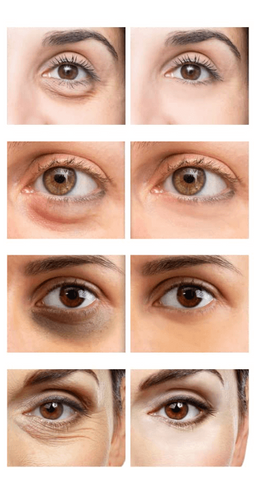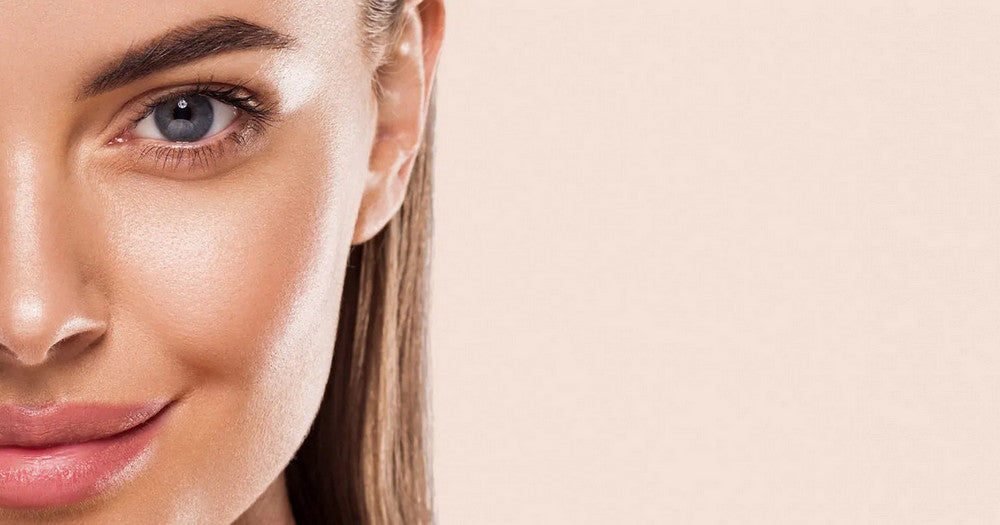Do you have bags under your eyes that just won't go away? Are you wondering if they're due to a health problem, lack of sleep or genetics? Are you tired of looking tired all the time because of those unsightly puffiness? Well, although bags under your eyes are rarely caused by health problems, there are other factors that can be responsible. That's exactly what we want to talk about here.
Some people have naturally-grown bags under their eyes and find them difficult to get rid of. Others develop puffy eyes due to lack of sleep, aging, allergies, a high-salt diet, or smoking. So, let's take a closer look at exactly how these factors can lead to under-eye puffiness.
In addition, we will introduce you to both temporary and long-term solutions that will allow you to easily treat your eye bags at home or in a clinic. You will also learn how to prevent them if you don't have them yet and want to always have healthy, fresh and radiant eyes.
What are bags under the eyes?
Eye bags are swellings or small edemas just below the eyeball. They occur when the skin, muscles and underlying tissue of the eye lose firmness. This causes the supporting fat to shift under the lower eyelid or fluid to accumulate, causing the eyes to look puffy.
In addition to bags under the eyes, dark circles and sagging skin under the eyes may also be visible. These bags usually do not cause any other eye problems such as irritation, visual disturbances or headaches. However, they are often a cosmetic concern. But don't worry, you can get rid of them.

What causes bags under your eyes?
Bags under the eyes can have various causes. Most of them are due to an unhealthy lifestyle, genetic predisposition and the natural aging process, but they can also be caused by certain diseases. Let's learn more about them step by step.
1. Aging
One of the most common causes of natural eye bags is the aging process. As we age, the tissues in the body change. Collagen production decreases and fat begins to accumulate under the eyes. At the same time, the skin and muscles become weaker. This causes the eyes of older people to appear puffy.
2. Lack of sleep
Have you ever noticed that your bags under your eyes are more noticeable after a sleepless night? Lack of sleep causes blood vessels to dilate and increases blood flow in the body. This effect is particularly noticeable under the thin skin of the eyes.
3. Allergies
Allergies can also cause sneezing, a runny nose, and eye irritation, and can lead to sinus congestion. Swelling of the nasal cavities causes the eyes to appear puffy.
4. Nicotine and alcohol
Smoking reduces collagen production in the skin and also leads to insomnia. Both factors cause fluid to accumulate in the tissue under the eyes, causing bags under the eyes.
Alcohol consumption causes the skin to dry out. Dry skin becomes weakened and promotes the formation of bags under the eyes.
5. Genetics
The most stubborn eye bags are caused by genes, so if several members of your family have them, it's probably hereditary.
6. Diet
Another cause you may not have considered is your diet. A diet that is high in salt and includes lots of fast food, processed snacks, and preserved meats can lead to fluid retention under the eyes. This can cause puffy eyes.
7. Sunbeams
The sun's UV rays damage skin cells, reduce the skin's collagen content and make it more susceptible to the formation of dark bags under the eyes.

8. Stress
Stress leads to an increased release of cortisol, the stress hormone in the body. Cortisol dilates the blood vessels and increases blood flow to the tissue. When this blood collects under the skin around the eye, the appearance of bags under the eyes is created, making the eye area appear baggy.
9. Diseases
Some diseases can also cause bags under the eyes. These include thyroid disease, dermatitis, chronic kidney disease and dermatomyositis. One of the most well-known of these diseases is thyroid disease.
How to avoid bags under the eyes
"Prevention is better than cure" - this saying also applies to bags under the eyes. The best way to avoid getting bags under the eyes is to prevent them from forming in the first place. Here are some simple ways to prevent bags under the eyes from forming.
1. Daily make-up removal

Makeup contains certain chemicals that can damage the skin and cause puffiness under the eyes. That's why it's important to remove makeup thoroughly every day to prevent bags under the eyes.
In addition, washing the face with cold water removes dust and impurities and soothes possible irritations caused by makeup.
2. Sunscreen
To prevent skin damage and bags under the eyes caused by UV rays, it is advisable to use sunscreen regularly. Sunscreen also helps prevent premature skin aging, so don't forget to consider the eye area when applying your favorite sunscreen.
3. Anti-aging serums
"Natural aging is the most common cause of under-eye bags and puffiness," explains Dr. Shaun Desai. So the best way to prevent under-eye bags is to slow down the aging process. Under-eye serums with hyaluronic acid and caffeine, as well as moisturizing creams rich in ceramides, can help keep under-eye skin young and healthy.
How to treat bags under the eyes
Eye bags can disappear on their own over the course of the day. However, they can also become stubborn bags and cause constant cosmetic concerns. In such cases, there are different approaches to treatment. Here we will discuss treating eye bags at home and in the clinic.
Treatments for home
Consistency is key when treating under-eye bags at home. While these methods are effective, they are temporary, so it's important to use these natural methods to reduce under-eye bags consistently to see long-term results.

1. Cold compress
The increased blood flow causes the blood vessels to dilate and increases the swelling under the eyes. To reduce this, you can place cold compresses such as ice cubes, chilled metal spoons, cucumber slices or ice packs on your eyes. This will constrict the blood vessels, reduce blood flow and ultimately reduce the inflammation and swelling of the eyes.
2. Caffeine
Caffeine is a natural vasoconstrictor. Applying caffeine serums or creams on the eye bags can effectively reduce them. You can also use black tea ice cubes to achieve a similar effect.
3. Hemorrhoid creams
Hemorrhoid creams contain phenylephrine. Phenylephrine constricts blood vessels and reduces blood flow, improving the appearance of the eyes. However, these creams are not suitable for everyone and should not be used regularly as they can cause skin irritation.
4. Limiting alcohol and tobacco
As mentioned above, alcohol and smoking can cause bags under the eyes. Their effects are amplified when combined, so it is advisable to avoid excessive alcohol consumption and quit smoking to achieve more youthful and better hydrated skin.
5. Improve nutrition
It is important to limit the consumption of salty foods to reduce under-eye bags caused by salty snacks. Increasing the intake of hydrating foods and eating a diet rich in antioxidants can improve eye and skin health and prevent under-eye bags. Such foods include cucumbers, watermelon, blueberries and tomatoes.
6. Sufficient sleep
Long sleeps, the effects of blue light from cell phones, and restless nights can lead to tired and puffy eyes. Improving your sleep habits will improve sleep quality and reduce the appearance of bags under the eyes. Avoid using your phone before bed, instead read a relaxing book and take a soothing shower.
7. Treat the cause
Sometimes we focus on the wrong cause to get rid of bags under the eyes, so it is important to identify the right cause and work on it to reduce under eye puffiness.
Professional treatments
The most permanent method to get rid of bags under the eyes is treatment in the clinic.
1. Eyelid surgery
Lower eyelid surgery, also known as blepharoplasty, is an invasive procedure to remove bags under the eyes. During this procedure, the surgeon reduces sagging and wrinkles around the eyes, tightens the skin and muscles under the eyes, and removes excess fat.
After the operation, there is a recovery period of several weeks. This procedure can permanently remove the bags under the eyes.
2. Eye filler
Undereye fillers are a relatively inexpensive and non-invasive way to reduce under-eye puffiness. They involve injecting hyaluronic acid into the skin. This procedure helps to hydrate the skin, making it appear plumper, firmer and less sunken.
3. Skin rejuvenation
Laser resurfacing and chemical peels are other methods of skin rejuvenation. These procedures aim to remove the old, wrinkled top layer of skin and stimulate collagen production. The result is a reduction in under-eye bags and tighter, brighter-looking and firmer skin.
Conclusion
Bags under the eyes are a problem for many of us. They are caused by stressful everyday life, an unhealthy lifestyle and constant exposure to sunlight.
Although bags under the eyes are mostly just a cosmetic problem, we all strive for a youthful and healthy appearance, right? Therefore, we want to get rid of them and avoid them. In this article, we will talk about how bags under the eyes are formed, how you can prevent them and what treatment options are available.
Finally, we hope that after receiving all the relevant information about eye bags and puffiness, you will be able to deal with them better.




























